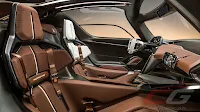In celebration of 75 years of Porsche sportscars, the German brand showcased their newest concept car: the Mission X. A design study for now, Porsche has admitted that it might go to limited production in due time. Regardless, it provides a glimpse into what hyper cars of the future could look like.
Joining the 959, the Carrera GT, and the 918 Spyder before it, the Mission X is a clear statement of what Porsche wants to achieve soon; a future driven primarily by electrification.
The Mission X concept study is relatively compact for a hyper car—4.5 meters in length and a width of around two meters. With its 2.73-meter wheelbase, however, it offers dimensions close to the Carrera GT and 918 Spyder. For aero purposes, the concept car has staggered tires with 20 inches at the front and 21 inches at the back. It’s also extremely low slung with an overall height at less than 1.2 meters.
Finished in Rocket Metallic—a new color made for the concept—the Mission X was designed for aerodynamic efficiency first and foremost. For example, the rear axle is fitted with almost transparent aero blades for better brake cooling. It also has a lightweight glass dome with an exoskeleton made of carbon fiber-reinforced plastic. Le Mans-style doors open forwards and upwards. Designers have also reinterpreted the brand’s four-point light graphic—now made to look vertical. At the back, a full-length light unit appears to float and illuminates the Porsche lettering. While charging, the “E” of the Porsche lettering pulses.
Another special detail is the modernized Porsche crest, which makes its debut on the Mission X. Brushed precious metal, a three-dimensional honeycomb structure, a refreshed heraldic beast, and more subtle gold color separate it from the previous logo.
In terms of interior, the Mission X has an asymmetrical layout with the two seats colored differently with the driver’s in gray and the passenger in brown. Beyond the CFRP seat shells, and their six-point seatbelts integrated into the monocoque, further motorsport parallels include the open-top steering wheel, which has mode switches and shift paddles. There are multiple cameras on board. Recording starts as soon as the driver presses the REC on the multi-purpose controller.
On the passenger side, the Mission X features a bayonet system in the instrument panel to which a stopwatch module can be attached. Porsche Design even created a special stopwatch with both an analog and digital display. The clocks are designed for both racetrack and rally use and can display the lap times or vital data of the driver, among other information.
Powering the Mission X is a 900-volt system architecture allowing it to charge twice as quickly as Porsche’s current champion, the Taycan Turbo S. The battery is installed centrally behind the rear seats. This layout, called E-Core, offers a weight distribution akin to a mid-engined vehicle.
No power or torque figures were revealed, but the automaker says the target would be one kilogram per horsepower in terms of power-to-weight, downforce values well above the 911 GT3 RS, and to be the fastest road-legal car on the Nürburgring Nordschleife.










No comments:
Post a Comment
Feel free to comment or share your views. Comments that are derogatory and/or spam will not be tolerated. We reserve the right to moderate and/or remove comments.